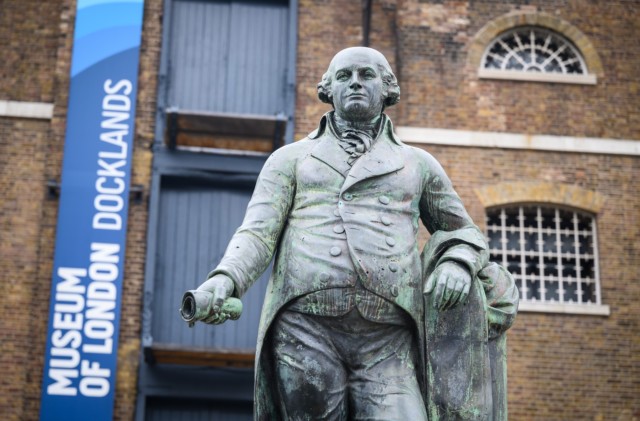PROTESTERS want 78 statues and street names across the UK taken down because of their racist associations.
A map showing all of the “racist” statues in Britain include memorials of Captain Cook and Wetherspoons pubs named after slave owners has been put up on a website called Topple the Racists.
The tearing down of Edward Colston’s statue in Bristol sparked a furious debate over which people get honoured with memorials in Britain, and a statue in London of 18th century slave trader Robert Milligan was taken down on Tuesday night.
The website was published by the Stop Trump coalition in support of the Black Lives Matter protests and maps out 78 statues across Britain which pay tribute to slave traders and “racists”.
The group said: “We believe these statues and other memorials to slave-owners and colonialists need to be removed so that Britain can finally face the truth about its past – and how it shapes our present.”
What statutes do protesters want taking down and why?
Christopher Columbus
One of the statues they want taken down is famed explorer Christopher Columbus, which sits in Belgrave Square in London..
The explorer was called the founder of the “New World” but protesters want his statue torn down for his exploitation and colonisation of the Americas.
An older understanding of the “discovery” of the Americas praised Columbus’ expedition as a great triumph and bringing huge wealth to Spain and other European countries through pillaging the land.
But more recent histories of the adventurer have focused on the slave trade in the Americas and the imported European diseases which wiped out indigenous peoples of the Caribbean region and American continents.
Historians have credited Columbus’ “discovery” of the Americas as the beginning of the slaughter of 3 million people.
A young priest who transcribed Columbus journals’ wrote: “There were 60,000 people living on this island, including the Indians; so that from 1494 to 1508, over 3,000,000 people had perished from war, slavery, and the mines.
“Who in future generations will believe this? I myself writing it as a knowledgeable eyewitness can hardly believe it.”
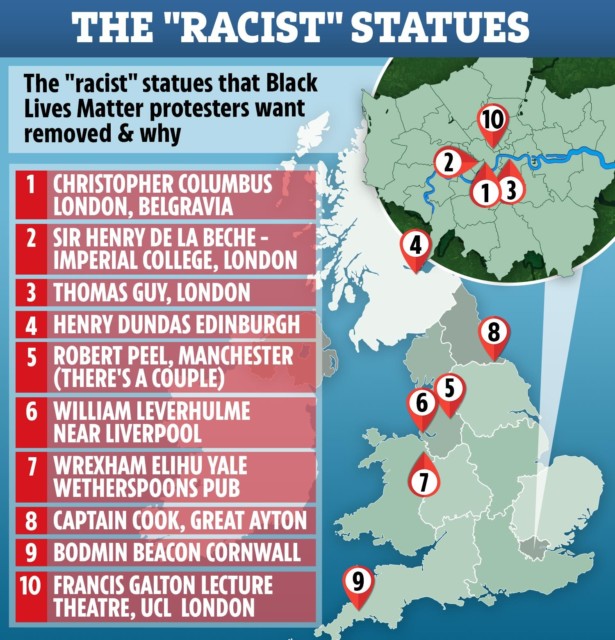
Thomas Guy
Thomas Guy was a philanthropist who founded Guys’ Hospital in London.
A King’s College London campus is named after him and a statue in Southwark pays tribute to him.
He was member of Parliament for Tamworth from 1695 to 1707; he also was chosen sheriff of London but declined to serve.
Guy made his fortune off of the slave trade.
He owned shares in the South Sea Company, who sourced slaves via the Royal African Company.
Before the share price crashed in 1720, Guy sold his at peak price and amassed a fortune.
The SSC was responsible for the transportation of about 64,000 African slaves between 1915 and 1731.
According to the website set up by the protesters, the company also had contracts to kidnap people and deliver them to Jamaica.
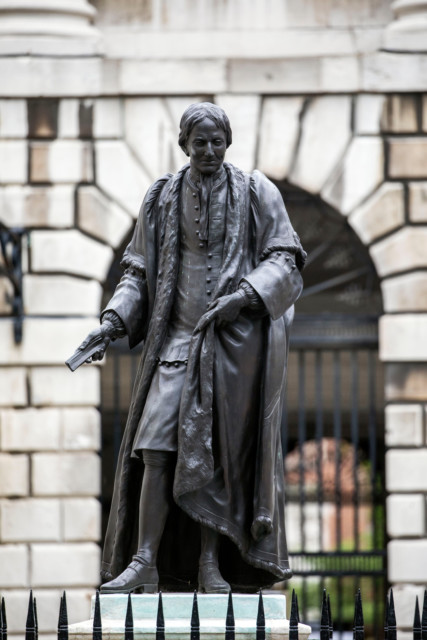
Henry Dundas
Henry Dundas, the First Viscount Melville, has a statue in St Andrew’s Square and protesters also want streets bearing his name changed.
Dundas was a politician who studied at the University of Edinburgh.
According to protesters: “He was solely responsible for delaying the abolition of slavery in 1792, causing another 15 years of people being kidnapped, shipped to, and enslaved in Britain (that’s around 630,000 more people) from which he directly benefited from.”
Dundas was also the first lord of the Admiralty and he was accused of misappropriating public money.
Though he was acquitted, he never again held office.
Robert Peel
Sir Robert Peel was the British Prime Minister from 1834-35 and then again from 1841-46.
Sir Robert was the son of a wealthy cotton manufacturer, also called Robert Peel.
There is some confusion amongst the protesters over which Robert Peel they are railing against.
They claim Sir Robert petitioned against the Foreign Slave Trade Abolition Bill in 1806, but that was actually his father – the cotton manufacturer and British MP.
Sir Robert would still have been a teenager at the time.
Campaigners have said Sir Robert’s family fortune was made off of the backs of slaves and he should no longer be honoured with a statue.
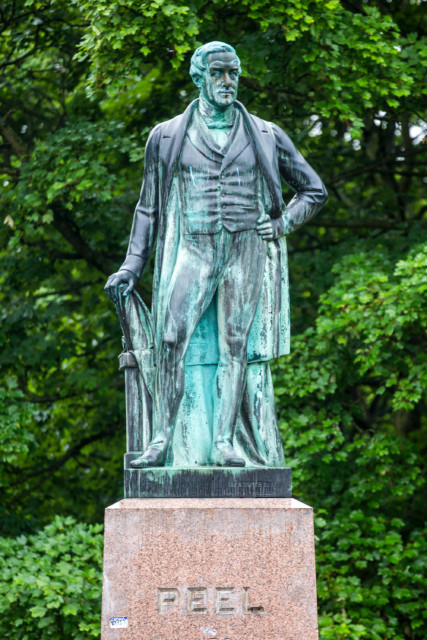
William Leverhulme
Lord William Leverhulme built one of Britain’s largest soap companies in the 1800s.
He made the first modern multinational business, and while he was known for caring for the welfare of his white workers, he exploited African slaves to make his fortune.
He set up palm oil plantations – the Lever plantations in the Congo – for forced labour.
Beatings and squalid conditions were the daily reality for most of the slaves.
The land was leased to him by his close friend King Leopold II long after slaver was officially ended in Britain.
A monument commemorates his philanthropy near Liverpool.
Elihu Yale
Protesters even want a Wetherspoons pub named after American-born Elihu Yale, a slave trader from the 17th century, changed.
Yale was the president of the East India Company settlement in Fort St. George, at Madras.
He was later booted from office after being charged with “self-aggrandizement” at company expense.
He was forced to pay a fine, but Yale was still able to take a massive fortune back with him to England. In London he entered the diamond trade, but he devoted a good deal of his time and money to philanthropy.
Protesters said: “He enforced a law that at least ten slaves should be carried on every ship bound for Europe.
“In his capacity as judge he also on several occasions sentenced so-called “black criminals” to whipping and enslavement.”
After a petition in 2017 the pub sign was removed, which showed Yale alongside a slave in chains.
But the protesters want the pub to change the name entirely.
The management are saying that they are now “considering a name change”.
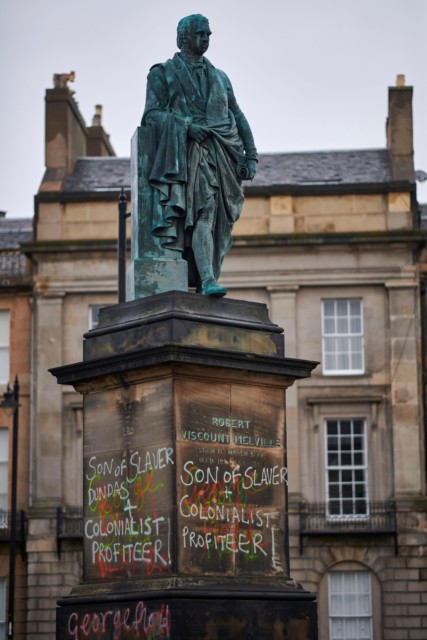
Captain Cook
A statue of explorer James Cook sits in Great Ayton.
Captain Cook was famous for discovering and colonising Australia and New Zealand.
Captain Cook’s “discovery” led to the deaths of Maori people in New Zealand and indigenous Australians.
Sir Walter Raleigh Gilbert
The Bodmin Beacon memorial, erect in 1856, commemorates the service of Sir Walter Raleigh Gilbert in India.
Sir Walter was an army in the British East India Company.
Protesters said: “In 1849 he lead a division of East India Company soldiers responsible for killing 6000 Sikhs during the Second Anglo-Sikh War.”
Francis Galton
A lecture theatre at University College London is named after Francis Galton.
Galton has been called the father of eugenics and wanted to build a “improved human race”.
He coined the term Eugenics himself.
Galton wrote 9 books and 200 papers in his life time about dozens of subjects including the use of fingerprints for personal identification, the correlational calculus (a branch of applied statistics), criminality, blood transfusions and meteorology.
He was knighted in 1909.
‘A more diverse London’
The news comes after London Mayor Sadiq Khan demanded statues and plaques be removed and street names in London changed if they commemorate slave owners.
Mr Khan told Sky News yesterday: “We’ve got to realise that our public realm statues, squares, street names don’t accurately reflect our values, or London, in 2020.”
But he added: “I don’t condone at all any attacks on our police, any disorder or criminal damages.”
Meanwhile, it has been announced 130 Labour councils across England and Wales will begin reviewing monuments and statues in their towns and cities.
It means dozens more monuments could be removed.
A statement posted on Twitter said: “LGA Labour have consulted with all Labour council leaders, and there is overwhelming agreement from all Labour councils that they will listen to and work with their local communities to review the appropriateness of local monuments and statues on public land and council property.”
And in Scotland, Adam McVey, leader of Edinburgh city council, told BBC Radio Scotland he would feel “absolutely no sense of loss” if the statue of Henry Dundas, 1st Viscount Melville responsible for delaying the abolition of the slave trade by 15 years, was removed from the 150ft Melville Monument.
On June 9 a statue of Robert Milligan – thought to have owned some 500 slaves – was removed from the West India Quay in east London following a petition from a Labour MP.
Milligan was the driving force behind the building of the West India Docks in London.
He also traded slaves in Jamaica.
Reports say the statue’s removal was met with cheers and applause from onlookers.
Milligan’s statue had stood outside the Museum of the Docklands near the West India Quay he helped create near Canary Wharf.
